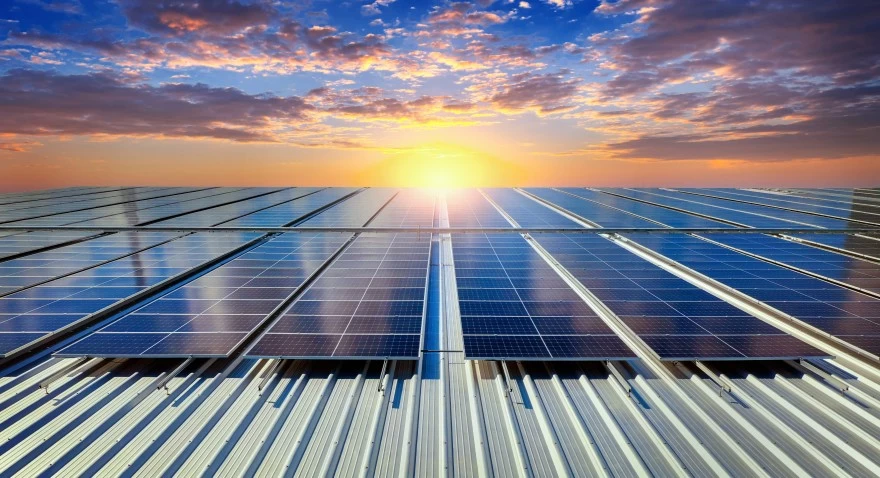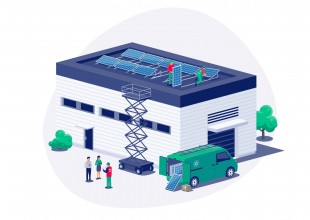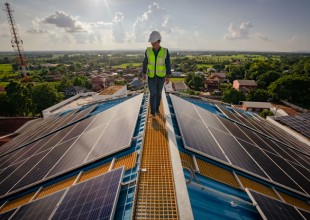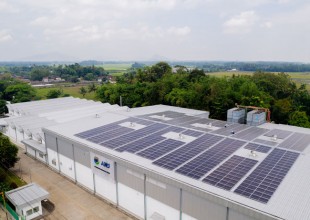Full Summary of Indonesia’s RUPTL 2025–2034: Renewable Energy as the New National Energy Direction

Indonesia has officially launched the Electricity Supply Business Plan (RUPTL) 2025–2034, a strategic document that will guide the development of the national electricity system over the next decade. More than just a technical plan, this RUPTL reflects Indonesia’s broader vision to build an energy system that is clean, self-reliant, and equitable.
Developed based on the National Energy Policy (KEN) and the National Electricity General Plan (RUKN), the latest RUPTL is also a concrete step toward energy self-sufficiency, while supporting the nation’s commitment to achieving Net Zero Emissions by 2060.
Key Highlights of RUPTL PLN 2025–2034:
1. Renewable Energy as the Backbone of the National Electricity System
The government aims to achieve a total of 69.5 gigawatts (GW) in new power generation capacity by 2034. Of this, 76% will come from renewable energy sources such as solar, hydro, wind, and geothermal, supported by energy storage systems like batteries and pumped-storage hydropower.
A more detailed breakdown of Indonesia’s planned power capacity additions under the RUPTL 2025–2034 is as follows:
- 42.6 GW (61%) from renewable energy (RE) sources:
- Solar: 17.1 GW
- Hydro: 11.7 GW
- Wind: 7.2 GW
- Geothermal: 5.2 GW
- Bioenergy: 0.9 GW
- Nuclear: 0.5 GW
- 10.3 GW (15%) from energy storage systems:
- Pumped-storage hydropower: 6.0 GW
- Battery storage: 4.3 GW
- 16.6 GW (24%) from fossil fuel-based generation:
- Gas: 10.3 GW
- Coal: 6.3 GW
The transformation of Indonesia’s electricity system is planned to occur in two phases. During the first five years (2025–2029), power development will remain relatively balanced between renewables, fossil fuels, and storage technologies, with the following projected mix:
- Fossil fuels (gas & coal): 12.7 GW (45%)
- Renewable energy: 12.2 GW (44%)
- Storage: 3.0 GW (11%)
However, in the second phase (2030–2034), the direction becomes much clearer, with a strong emphasis on clean energy. The planned composition is:
- Renewable energy: 30.4 GW (73%)
- Storage: 7.3 GW (17%)
- Fossil fuels: 3.9 GW (10%)
This RUPTL does more than outline a construction schedule, it provides a realistic and measurable roadmap for Indonesia’s transition to a greener, more self-reliant energy system that is resilient to global energy fluctuations.
2. Power Plant Development Distributed Equally Across Indonesia
- In addition to increasing national electricity capacity, RUPTL PLN 2025–2034 emphasizes balanced development across all regions of Indonesia. The planned additional capacity of 69.5 GW will be distributed throughout the country, with the type and share of energy tailored to each region’s natural resource potential.
- Java, Madura, and Bali are projected to receive the largest share of development, with a total of 33.5 GW, including 19.6 GW from renewable energy sources, primarily solar (10,932 MW) and wind (5,377 MW). This reflects the government’s strategy to align high electricity consumption areas with increased clean energy generation.
- Sumatra will see a total of 15.1 GW in new capacity, including 9.5 GW from renewables. The region’s abundant rivers and geothermal activity make it particularly well-suited for hydro and geothermal power generation.
- Sulawesi is expected to add 10.4 GW, with 7.7 GW coming from renewable sources. The mix is relatively balanced, consisting of hydro, solar, and wind power plants.
- Kalimantan will develop 3.5 GW of renewable capacity, largely through hydro and solar, leveraging its large river systems and strong solar potential.
- Meanwhile, the Maluku, Papua, and East Nusa Tenggara regions will receive 4.7 GW of total additions, with 2.3 GW coming from renewables, particularly solar and wind. This development underscores the government's commitment to ensuring the energy transition reaches 3T regions (underdeveloped, frontier, and outermost areas), in support of equitable access and energy justice across the archipelago.
3. Strengthening Power Infrastructure to Support Clean Energy
RUPTL 2025–2034 specifically targets the strengthening of Indonesia’s national electricity infrastructure, both in terms of transmission lines and substations, so that clean energy can be delivered efficiently and equitably across the country.
Over the next ten years, PLN (Indonesia’s State-Owned Electricity Company) plans to build 47,758 circuit kilometers of transmission lines and expand substation capacity by 107,950 MVA. These infrastructure projects will be distributed across three major regional zones:
- Java, Madura, and Bali: 13,889 kms
- Sumatra and Kalimantan: 20,967 kms
- Sulawesi, Maluku, and Papua: 12,901 kms
This development will not only enhance the reliability of Indonesia’s national power grid, but also support regional economic growth, accelerate rural electrification, and drive the development of clean energy–based industrial zones.
4. Driving Economic Growth and Green Investment
RUPTL PLN 2025–2034 is designed to support the government’s broader goal of achieving 8% economic growth by 2029.
To meet this objective, Indonesia’s electricity demand must increase in tandem with industrial expansion and digital transformation. According to PLN projections, electricity demand is expected to grow from 306 TWh in 2024 to 511 TWh by 2034, an increase of 205 TWh, or roughly 21 TWh per year.
This growth will be driven by strategic sectors such as:
- Industrial estates and special economic zones (SEZs)
- Priority tourism destinations (DPSPs)
- Data centers
- Mineral downstreaming and electric vehicles (EVs)
- Integrated marine and fisheries zones
To finance this transition, the government has opened up nearly IDR 3,000 trillion (approx. USD 190 billion) in investment opportunities through 2034. Notably, around 73% of this total, approximately IDR 1,566.1 trillion, will be channeled through private sector participation via the Independent Power Producer (IPP) scheme. The remaining IDR 567.6 trillion will be managed directly by PLN Group.
Of the IPP investment, IDR 1,341.8 trillion is earmarked for renewable energy projects, while IDR 224.3 trillion is allocated for conventional power plants. On the PLN side, IDR 340.6 trillion is dedicated to renewables and IDR 227 trillion to fossil fuel generation.
This model positions Indonesia’s energy transformation as a shared responsibility, where the government and private sector work together to advance a clean, inclusive, and future-oriented energy economy. RUPTL 2025–2034 lays a clear path for solar energy developers and clean tech investors to play an active role in building that future.
5. Unlocking the Potential for Over 1.7 Million Jobs
Behind the substantial investment figures in RUPTL 2025–2034 lies a significant social impact, particularly in job creation. The government estimates that the implementation of this plan will generate more than 1.7 million new jobs across the country.
Of the total, 836,696 jobs are expected to be created in the power generation sector, covering roles in manufacturing, construction, operations, and maintenance of power plants. Meanwhile, approximately 881,132 jobs will support the development and operation of transmission lines, substations, and distribution systems across Indonesia.
A significant portion of these new jobs will come from the renewable energy sector. In the generation segment alone, over 760,000 positions, or around 91%, are projected to be green jobs, which directly contribute to sustainable development and environmental protection.
6. Electricity for All, from Cities to Villages
RUPTL 2025–2034 also places strong emphasis on ensuring energy access in underdeveloped, frontier, and remote areas (known as 3T regions). Through the Village Electrification Program, the government aims to provide electricity to over 5,700 new villages, reaching a total of 780,000 households. This initiative highlights that the energy transition is not just about technology; it is also a concrete expression of social equity, ensuring that clean energy reaches all citizens across the archipelago.
Solar Energy as a Central Focus in the Energy Transition
With increasingly affordable technology, scalable installation options, and abundant sunlight throughout the country, solar energy has officially become a cornerstone of Indonesia’s future electricity system, supporting the national effort to transition toward a cleaner, more reliable, and self-sufficient energy system.
In addition to reducing carbon emissions, the development of solar energy system also presents strategic opportunities for businesses. Industries in Indonesia are increasingly encouraged to adopt clean energy to boost global competitiveness, meet ESG (Environmental, Social, and Governance) standards, and respond to growing market and consumer demand for environmentally responsible practices.
Solar energy system offers a practical solution for efficient electrification and industrial decarbonization. With the right solar system in place, businesses can reduce operating costs, enhance energy security, and build a stronger sustainability image among investors and international partners.
Make Your Business Part of Indonesia’s Energy Transition
SUN Energy provides reliable, fully integrated solar energy system solutions for commercial and industrial sectors, supporting your company’s clean energy goals and operational efficiency.
Contact SUN Energy for more information!
WhatsApp: http://wa.me/+62881012251888
Email: [email protected]
Sources:
- https://www.esdm.go.id/id/media-center/arsip-berita/menteri-esdm-umumkan-ruptl-pln-2025-2034-serap-lebih-dari-17-juta-tenaga-kerja-baru
- https://gatrik.esdm.go.id/assets/uploads/download_index/files/4ec39-materi-paparan-ruptl-2025-2034.pdf


